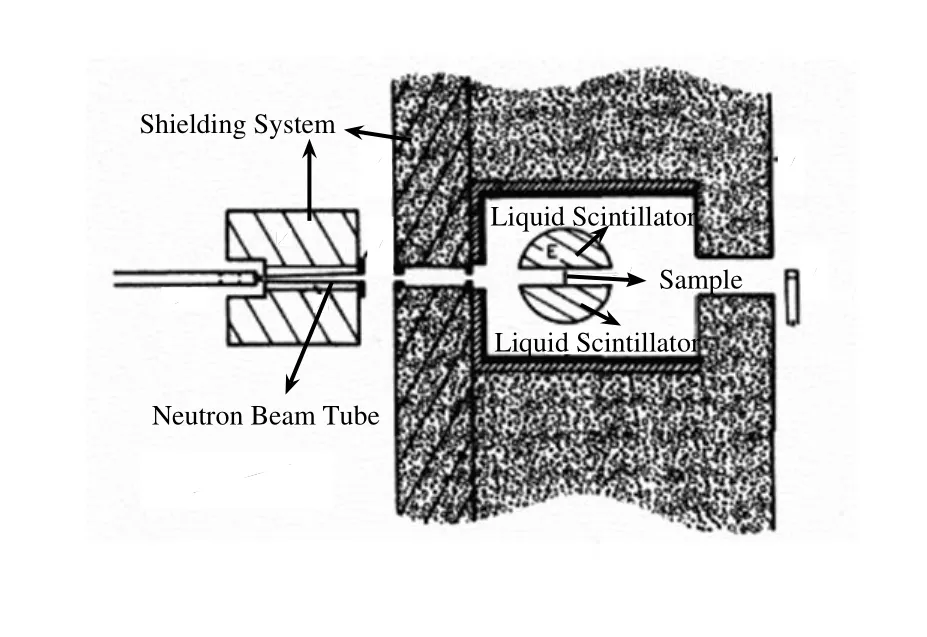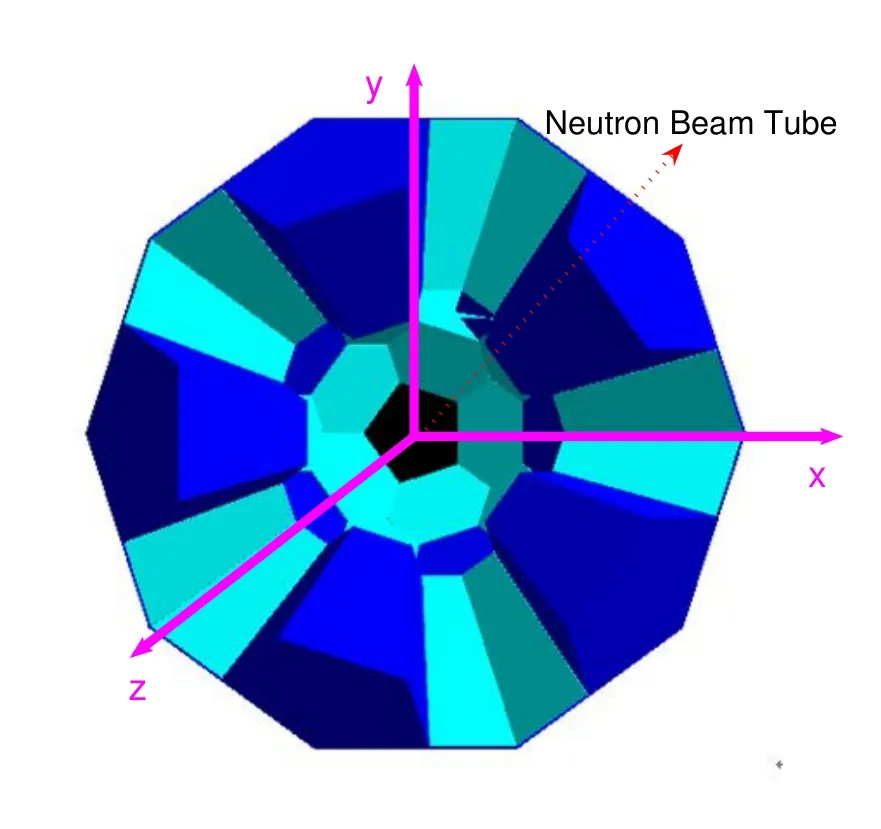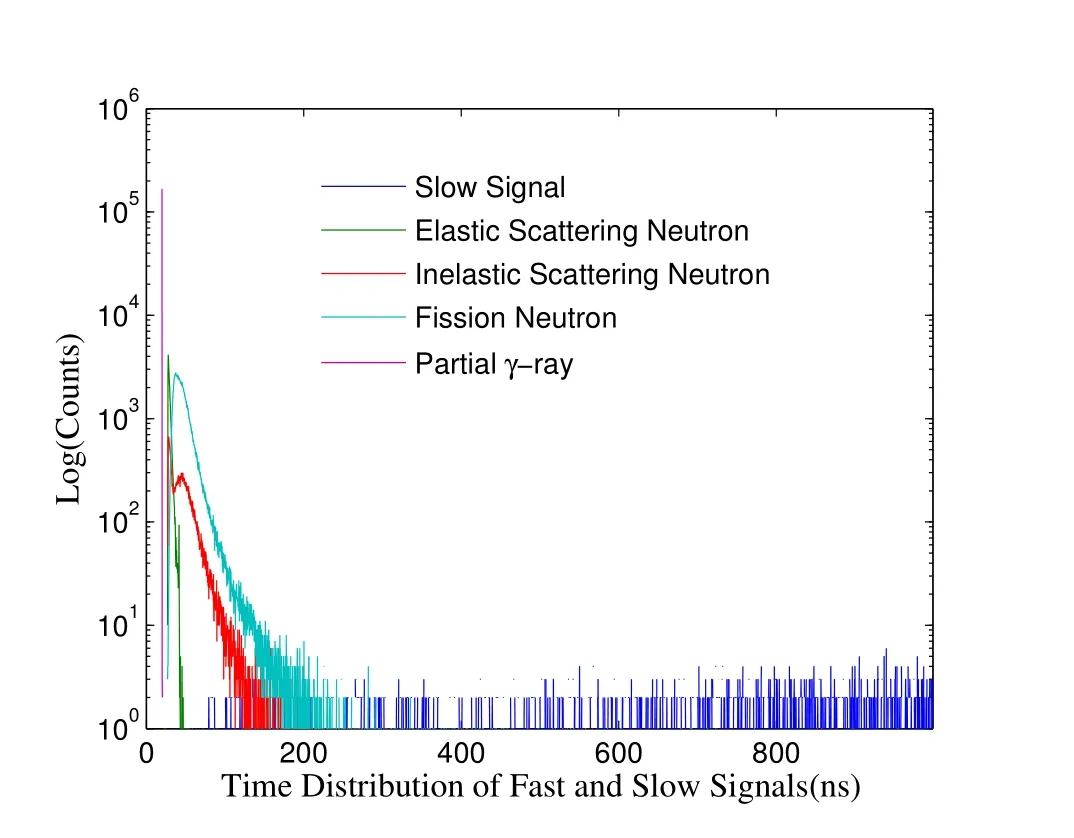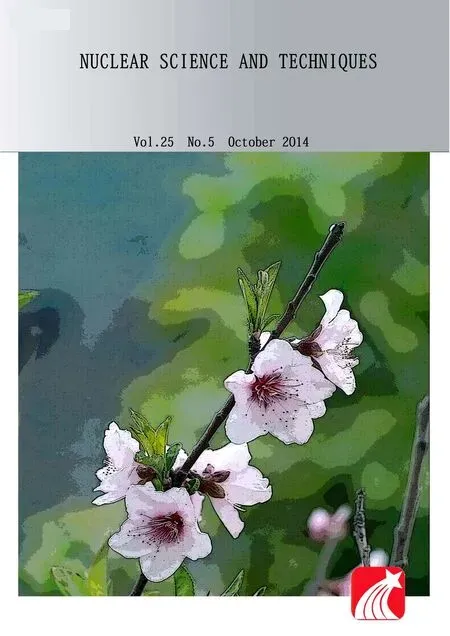A novel 4π Gd-loaded liquid scintillator detection system∗
2014-08-05YUGuoLiang于国梁DONGLianJie董连洁LONGHou侯龙LUHanLin卢翰林andTANGHongQin唐洪庆
YU Guo-Liang(于国梁),DONG Lian-Jie(董连洁),LONG Hou(侯龙),LU Han-Lin(卢翰林),and TANG Hong-Qin(唐洪庆)
1Department of Mathematics and Physics,North China Electric Power University,Baoding 071003,China
2College of Science,Agriculture University of HeBei,Baoding 071001,China
3Institute of Nuclear Physics,China Institute of Atomic Energy,Beijing 102413,China
A novel 4π Gd-loaded liquid scintillator detection system∗
YU Guo-Liang(于国梁),1,†DONG Lian-Jie(董连洁),2LONG Hou(侯龙),3LU Han-Lin(卢翰林),3and TANG Hong-Qin(唐洪庆)3
1Department of Mathematics and Physics,North China Electric Power University,Baoding 071003,China
2College of Science,Agriculture University of HeBei,Baoding 071001,China
3Institute of Nuclear Physics,China Institute of Atomic Energy,Beijing 102413,China
With a Geant4 software package based on the Monte Carlo method,a multi-cell 4π detection system is designed,which consists of 40 Gadolinium-loaded liquid scintillation detectors.These detectors,associated with a fi ssion chamber in its geometrical center,constitute a platform.This platform is mainly used for the measurement of a fi ssionable nucleus(n,2n)reaction cross section.In order to properly determine the experimental set-up,we carry out a systematic numerical simulation using our model which is established by the Geant4 software package.This work provides rich and valuable reference data for experiments on the fi ssionable nucleus (n,2n)cross section measurement in the future.
(n,2n)cross section,Geant4,Gadolinium-loaded liquid scintillator
I.INTRODUCTION
(n,2n)nuclear reaction plays the role of neutron multiplication in the reactor,so an accurate measurement of the fi ssionable nucleus(n,2n)cross section has an important signi fi cance in the utilization of nuclear energy and nuclear technology[1].People have employed a variety of methods to carry out this work.Activation technique is one of the commonly used methods,but it requires the residual nucleus appropriate half-life.In addition,this method has a higher requirement for the purity of the samples and the intensity of incident neutrons[2,3].Partial γ-ray method is a technique that combines with the theoretical model loading to a nuclear reaction.But it depends too much on the theoretical model,which leads to great uncertainty to the experimental results[2,3].The large Gadolinium-loaded liquid scintillator was introduced by Frehautet al.in 1976 for its 80%neutron detection ef fi ciency[4,5].The principle of this direct measurement method is shown in Fig.1,two hemispherical containers contain liquid scintillator and a dozen photomultiplier tubes surround the containers to collect the signal from the Gd-liquid scintillator.After being collimated,the monoenergetic neutrons irradiate the samples located in the geometric center of the system.The neutron coming from the nuclear reaction is moderated within a few nanoseconds in the liquid scintillator,and generates a neutron pulse(usually called fast signal).Since Gd isotopes mainly155Gd and157Gd have a high thermal neutron capture cross section,there is a great probability that the neutron will be captured by the Gd.Gd isotopes in an excited state will emit several cascade γ-rays with a total energy of about 8MeV,and the pulse caused by these captured γ-rays is called the slow signal.Because ofthe high energy of this pulse,we can easily discriminate it from common background events such as γ-ray and scattering neutron events,whose energy is less than 3MeV.And such a pulse with an energy of 8MeV indicates that a neutron is probably produced in the nuclear reaction.Thus,we can exactly determine the number of neutrons produced in a nuclear reaction.

Fig.1.Experimental set-up.
This methoddoes notrely onthe theoreticalmodel,and has no requirement for the half-life of the residual nucleus[4–7]. However,the fi ssion neutrons will bring great deviation to the measuring results of the fi ssionable nucleus(n,2n)cross sections.In addition,because the detection system has a large sensitive volume,the γ-rays in the background have a significant additive effect,resulting in a high γ background.And each γ-ray penetrated in the detection system can make all the photomultipliers respond,so the total counting rate of the detection system is very high,which results in a high dead time for the detection system.

Fig.2.(Color online)Pro fi le of the detection system.

Fig.3.(Color online)Transverse cross-section of the detection system.
Considering the above disadvantages of the large Gdloaded liquid scintillator technique,we improved this technique by a novel design of one 4π detection system,which consists of 40 Gd-loaded liquid scintillatior sub-detectors (Figs.2 and 3).In this experiment,the multi-cell structure can effectively reduce the counting rates of a single detector, so as to decrease the dead time.We will also see from Sec. III A of this paper that this technique has certain(n,γ)discriminations,which can effectively reduce the in fl uence of γ background on the experimental results.To measure the fi ssionable nucleus(n,2n)cross section,samples are placed in the fast fi ssion chamber,which is located at the geometrical center of the detection system.The pulse output from the fi ssion chamber will be used to exclude the fi ssion neutron. Thus,the in fl uence of the fi ssion events on the experimental results will be greatly reduced.This platform can not only be used to measure the(n,2n)and(n,3n)cross sections,but also to measure the neutron properties such as the angular distribution and angular correlation.Thus,the results provided in this work are very important for neutron experiments in the future.
II.STRUCTURES AND BASIC PERFORMANCE OF THE DETECTION SYSTEM
A.Structure of the detection system
In order to cover the 4π solid angle,every two adjacent detection units in the detection system should realize the seamless connection.At the same time,each detection unit should have an approximately equal solid angle to the geometrical center of the system to maintain the same detection ef fi ciency, According to Ref.[8,9],a detection system containing 40 detection units is designed,in which each unit is numbered as shown in Fig.2.The detection units used in this system have two kinds of shapes whose transverse sections are pentagonal and hexagonal,respectively.In the center of the detection system a cavity is left(Fig.3),which is used to hold the fast fi ssion chamber.Furthermore,in order to design the neutron beam tube,two detection units are extracted from the detection system(Fig.3).Each detection unit is a container which has an aluminum shell with a thickness of about 3mm.These detection units are all fi lled with the common liquid scintillator used in the neutron experiment.The liquid scintillator is mixed into a Gd isotope by a mass percentage concentration of 0.5%.The ratio of carbon to hydrogen is approximately 3∶4 in the liquid scintillator and the density is about 0.87g/cm3.
B.Performance of the detection system
1.Response of the detection system to the neutron source252Cf
The spontaneous fi ssion neutron source,252Cf,is often used for the ef fi ciency calibration in the neutron detection experiment.Therefore,we simulate this kind of neutron source, put it in the geometric center of the detection system,and analyze the response of the detection system toitwith our Geant4 model.Partial γ-rays are emitted from excited Gd isotopes after they capture a neutron,we show the energy spectrum that these γ-rays deposit in detection unit and detection system,respectively(Fig.4).Since γ-rays primarily lose their energy in the form of the Compton Effect in a liquid scintillator[10],the γ-ray energy spectrum of a single detection unit is the Compton plateau whose edge is approximately at the position of 8MeV.The detection system has a large sensitive volume,and the energy of these cascade γ-rays can be fully deposited in it after several Compton scatterings,thus a fullenergy peak is formed at the position of 8MeV.In addition, we also show the neutron ef fi ciency curve in Fig.5(In Figs.5 and 6,‘Th’means the threshold value of a single detection unit).The neutron ef fi ciency is de fi ned as


Fig.4.(Color online)γ-rays spectrum of the detection system and a detection unit.

Fig.5.(Color online)The curve of the neutron detection ef fi ciency versus the thickness of the detection unit.
where∈is the neutron ef fi ciency,Nγis the total counts in the γ-ray spectrum caused by neutron events whilst theNnis the total number of the neutron events.In the experiment, the detector threshold is usually far below 1.0MeV.We can see from Fig.5 that the ef fi ciency of a single neutron is over 80%,except for the curve at the bottom,and they increase rapidly with the increasing thickness of the detector.When the thickness is over 60cm,the ef fi ciency curve gradually fl attens out.It is indicated from Fig.6 that the variation of the cavity radius has limited in fl uence on the coincidence effi ciency of two neutrons,except when the detector threshold is 2.0MeV.To minimize the volume of the whole detection system,which also has a high neutron ef fi ciency,the thickness of the detector is preliminarily determined to be 60cm. Furthermore,considering a fi ssion chamber will be placed in the center of the detection system,we chose the cavity radius to be 30cm.

Fig.6.(Color online)The curve of coincidence ef fi ciency about two neutrons versus the inner-radius of the detection system.

Fig.7.(Color online)Statistical results about the distribution of the energy deposition in detection units.
2.Distribution of γ-ray energy deposition in the detection system
The neutron source,252Cf,which is placed in geometric center of the detection system emits neutrons in the direction of the detection unit 36(Fig.2).If the neutron is captured by the Gd isotope in unit 36,the deposited energy of the capture γ-rays in each detection unit will be recorded.According to the simulation,we give out the distribution of the energy deposition in the detection system,which is shown in Fig.7.We can see in Fig.7 that the γ-rays deposit most of their energy in several adjacent units such as 36,20,21,26, 11,and 27.These adjacent detection units are called partial detection units,where about 60%of the captured γ-rays energy is deposited.This characteristic can be understood as follows.Although the total energy of the captured γ-rays is close to 8MeV,they commonly include several γ-rays whose energy is about 1~2MeV.Because their penetrating power isvery limited,most of their energy is deposited in several adjacent detection units.This indicates that partial detection units (composed of 6~7 adjacent detection units)will respond to the event fi red by a neutron.However,eachγ-ray coming from the background is commonly low-energy,so it will deposit most of its energy in one or two detection units,which is obviously different from the neutron event.Thus,the number of fi red sub-detection units can be used as a judgment of a neutron event in the future,so as to reduce the γ-rays background coming from the environment.
III.NUMERICAL SIMULATIONS ABOUT THE EXPERIMENT
A.Experimental set up in simulation
The fast fi ssion chamber used in the detection system is a multi-target chamber,which can effectively reduce the selfabsorption of the fi ssion fragment without in fl uencing the (n,2n)reaction rate[11].The(n,2n)reaction threshold of the aluminum nuclei is relatively higher than other common metallic elements.Even if the(n,2n)channel is induced, its cross section is also small.So,duralumin is chosen as the structure material of the fast fi ssion chamber[11,12].The total mass thickness of the structure material is 2.7g/cm2.The fi ssion chamber is placed in the geometric center of detection system and its axis coincides with the axis of the neutron beam tube.235U is plated on both sides of the electrodes in the chamber,and the total mass thickness of the sample is about 100mg/cm2.The position of the monoenergetic neutronsource(14MeV)is3.5mawayfromthegeometriccenter of the detection system.With these conditions,the incident neutron may induce many kinds of nuclear reactions.
B.Characteristic of time distribution of the different events
In order to properly set up the pulse period of the incident neutron,the width of the detector gate and the time relationship between the gate signal and the neutron fl ux,we simulate the time distribution of different events which induce the response of the liquid scintillator.These events mainly include the fast signal(elastic scattering neutron,inelastic scattering neutron, fi ssional neutron,and partial γ-rays which are also produced by the samples)and slow signal(captured γ-rays which are emitted from excited Gd isotopes).In our simulation,we chose the time that the neutron source emits a neutron as the zero time.The time distribution of these different events is shown in Fig.8.As shown in Fig.8,what fi rst causes the detector to respond is the prompt γ-ray,and then the neutron events.The time distribution of these events is in the nanosecond order of magnitude;while Figs.8 and 9 show that the time distribution of the slow signal is in microsecond magnitude.Our simulation also shows that 99.5%of the fast signals distribute within 1µs.And only about 0.2%of the slow signals distribute in this interval(blue curve in Fig.8). Furthermore,95%of the slow signals distribute within 30µs and more than 99.7%distribute within 50µs.

Fig.8.(Color online)Time distribution of different events including fast and slow signals.
It is noted that the time distribution of slow signal is approximately equal to that of neutron capture by Gd.And this slow signal is what we are actually interested in,as it is actually used for neutron counting.To avoid the in fl uence of the fast signal,the detector gate should be opened after about 1µs of the neutron fl ux arrival.The time width of the detector gate signal should be set to about 30µs,during which the neutron is counted.The time between two consecutive neutron fl uxes ischosentobe60µs,whichisgreaterthanthelifetimeofneutrons in the scintillator.In Ref.[4–6],the above parameters used by Frehautet al.are 1.2µs,30µs and 60µs,respectively.

Fig.9.Time distribution of slow signal,which re fl ect the time distribution of neutron capture by Gadolinium.

TABLE 1.The numbers of different 2n events which induce the response of the detection system in our simulation
C.Estimation about the accuracy of the results
With a total number of 1.0×108neutrons irradiating the samplesinthe fi ssionchamber,wecarryoutasystematicsimulation of the experiment.Table 1 lists the kinds of the 2n events that the detection system records.These 2n events can be ascribed to the following reasons,the fi ssion reaction of uranium,the(n,2n)reaction of uranium,aluminum,and the accidental coincidence.The(n,2n)reaction of nitrogen(the main element in the air)should also be considered.If the effi ciency of the chamber is about 90%,only 10%of the 2n events(this number is about 750 in our simulation)from the fi ssion reaction can not be excluded from the experimental results.That is to say,the in fl uence of the fi ssion neutron on the experimental results can be reduced by one order of magnitude.When calculating 2n accidental coincidence events,the coincidence resolving time is equal to the width of the detector gate signal(30µs);the total intensity of the neutron source in the 4π direction is 108/s(The 108/s~109/s intensity can be achieved on the accelerator at the China Institute of Atomic Energy).
The2nbackgroundeventscausedbythestructurematerials (aluminum)of the chamber and nitrogen in the air can be deducted through the following method.Under the same conditions,we can determine these 2n background events with the neutron beam irradiating the fi ssion chamber without samples.Furthermore,simulation also shows that only 10%of the accidental coincidences are related to the samples[13], namely,90%of accidental coincidences can also be deducted through the above method.Therefore,the counting uncertainty of 2n events caused by aluminum,nitrogen,and accidental coincidence can be calculated together.And the uncertainty of net count can be estimated

Here,σt=117.38,σb=60.15,σf=27.36 which are listed in Table 1.Relative uncertainty is

whereNnet=9411 is what we are really interested in.
Of course,a few factors such as the accidental coincidence with cosmic rays and the energy resolution of the γ-ray spectrum are not considered at present.There will be some deviation in calculating the content of the sample;and the change of the neutron fl ux can also lead to deviation.So,the measurement of the(n,2n)cross section will be in fl uenced by many factors,except for those which we have considered. Correspondingly,the value of the experimental result uncertainty will be larger than that we estimate at present.However,the simulation results in our study are still important to the design and optimization of the experiment conditions in the future.
IV.CONCLUSION
According to the experiment setup of Frehautet al.,we designed a novel 4π multi-cell Gd-loaded liquid scintillator detection system for the measurement of(n,2n)nuclear reaction cross sections.This detection system makes up for the weakness of the original one used by Frehautet al.According to systematic simulation of the experiment,we preliminarily determined the thickness of the detector,the inner-radius of the detection system,the pulse period of the neutron source, the time width of the detector gate,and the time relationship between gate signal and neutron fl ux.Finally,we roughly estimated the accuracy of the experimental result under our experiment setup.
Certainly,there is much work that needs to be further carried out.As for the γ-rays spectrum,we only considered the energy loss process in the detector in our simulation,without considering the collection process of the fl uorescence photon.Considering this process,the γ-rays spectrum will have a lower energy resolution,and the energy resolution has an important in fl uence on the ef fi ciency.Therefore,the photogathering process should be considered in our Geant4 code in the future,so that the simulation will be more consistent with the experimental conditions.In addition,in order to reduce the in fl uence of the large angle scattering neutrons,cosmic rays and γ-rays,coming from the environment,we will put forth much effort to design a neutron beam tube and a shielding layer around the detection system.It mainly includes the selection of shielding materials,the calculation at the thickness of the shielding layer,and the diameter of the neutron tube.
[1]Zhang F and Kong X Z.J China Uni Petr,2003,27:128–130. (in Chinese)
[2]McNabb D P,Anderson J D,Bauer R W.Evaluation of the239Pu(n,2n)Integrated Cross Section(R).Livermore: Lawrence Livermore National Laboratory(LLNL),2001. http://www.doc.gov/bridge
[3]Shi Z R.Nucl Phys Rev,2002,19:42–44.(in Chinese)
[4]Frehaut J.Nucl Instrum Methods,1976,135:511–521.
[5]Frehaut J,Bertin A,Bois R.Nucl Sci Eng,1980,29:74–79.
[6]Frehaut J,Bertin A,Bois R.Radiat Eff Defects Solids,1986,96:219–224.
[7]Xiang Z Y.Nucl Phys Rev,1989,6:23–25.(in Chinese)
[8]Shu C,Zhou F J,Liang B,et al.J Henan Uni Sci Tech.,2007,28:53–56.(in Chinese)
[9]Shu C,Zhou F J,Liang B,et al.J Henan Uni Sci Tech.,2008,29:62–64.(in Chinese)
[10]Fudan University,Tsinghua University,Peking University.The Experimental Method for Nuclear Physics,1997,54–67.(in Chinese)
[11]Zhang H Q and Wen T Q.Atom Energ Sci Techol,1979,13: 113–121.(in Chinese)
[12]Kang G G.Master Degree Thesis,Chinese Institute of Atomic Energy,2012.(in Chinese)
[13]Yu G L.Ph.D.Thesis,Beijing:Chinese Institute of Atomic Energy,2012.(in Chinese)
10.13538/j.1001-8042/nst.25.050401
(Received February 18,2014;accepted in revised form March 13,2014;published online September 25,2014)
∗Supported by National Natural Science Foundation of China(No. 11375063)and the Fundamental Research Funds for the Central Universities(No.13QN59)
†Corresponding author,yuguoliang2011@163.com
猜你喜欢
杂志排行
Nuclear Science and Techniques的其它文章
- The effect of Nb additive on Te-induced stress corrosion cracking in Ni alloy:a fi rst-principles calculation∗
- Development and testing of the code for automatic generating of multi-temperature continuous-energy neutron cross section libraries∗
- Steady thermal hydraulic characteristics of nuclear steam generatorsbased on the drift flux code model∗
- A method of estimating and subtracting the hydrogen background in the natural carbon target used in the12C+12C experiment∗
- Density functional theory study of H,C and O chemisorption on UN(001)and(111)surfaces∗
- The extraction and smoothing algorithms for γ-ray spectrum of a CdZnTe detector system
